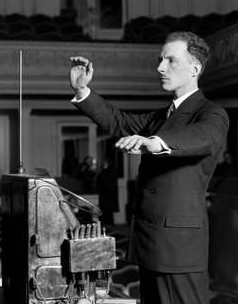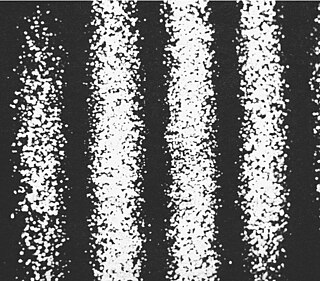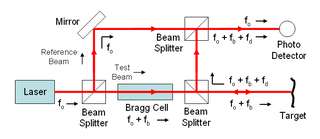Related Research Articles

Lev Sergeyevich Termen, better known as Leon Theremin, was a Russian inventor, most famous for his invention of the theremin, one of the first electronic musical instruments and the first to be mass-produced. He also worked on early television research. His secret listening device, "The Thing", hung for seven years in plain view in the United States ambassador's Moscow office and enabled Soviet agents to eavesdrop on secret conversations.

A microphone, colloquially called a mic, is a transducer that converts sound into an electrical signal. Microphones are used in many applications such as telephones, hearing aids, public address systems for concert halls and public events, motion picture production, live and recorded audio engineering, sound recording, two-way radios, megaphones, and radio and television broadcasting. They are also used in computers and other electronic devices, such as mobile phones, for recording sounds, speech recognition, VoIP, and other purposes, such as ultrasonic sensors or knock sensors.

Holography is a technique that enables a wavefront to be recorded and later reconstructed. It is best known as a method of generating real three-dimensional images, but also has a wide range of other applications. In principle, it is possible to make a hologram for any type of wave.
A covert listening device, more commonly known as a bug or a wire, is usually a combination of a miniature radio transmitter with a microphone. The use of bugs, called bugging, or wiretapping is a common technique in surveillance, espionage and police investigations.
A transducer is a device that converts energy from one form to another. Usually a transducer converts a signal in one form of energy to a signal in another. Transducers are often employed at the boundaries of automation, measurement, and control systems, where electrical signals are converted to and from other physical quantities. The process of converting one form of energy to another is known as transduction.

Soundproofing is any means of impeding sound propagation. There are several basic ways to reduce sound: increasing the distance between source and receiver, decoupling, using noise barriers to reflect or absorb the energy of the sound waves, using damping structures such as sound baffles for absorption, or using active antinoise sound generators.

Cymatics is a subset of modal vibrational phenomena. The term was coined by Swiss physician Hans Jenny (1904–1972). Typically the surface of a plate, diaphragm, or membrane is vibrated, and regions of maximum and minimum displacement are made visible in a thin coating of particles, paste, or liquid. Different patterns emerge in the excitatory medium depending on the geometry of the plate and the driving frequency.

Microphonics, microphony, or microphonism describes the phenomenon wherein certain components in electronic devices transform mechanical vibrations into an undesired electrical signal (noise). The term comes from analogy with a microphone, which is intentionally designed to convert vibrations to electrical signals.

A security alarm is a system designed to detect intrusions, such as unauthorized entry, into a building or other areas, such as a home or school. Security alarms protect against burglary (theft) or property damage, as well as against intruders. Examples include personal systems, neighborhood security alerts, car alarms, and prisons.

A light beam or beam of light is a directional projection of light energy radiating from a light source. Sunlight forms a light beam when filtered through media such as clouds, foliage, or windows. To artificially produce a light beam, a lamp and a parabolic reflector is used in many lighting devices such as spotlights, car headlights, PAR Cans, and LED housings. Light from certain types of laser has the smallest possible beam divergence.
Level sensors detect the level of liquids and other fluids and fluidized solids, including slurries, granular materials, and powders that exhibit an upper free surface. Substances that flow become essentially horizontal in their containers because of gravity whereas most bulk solids pile at an angle of repose to a peak. The substance to be measured can be inside a container or can be in its natural form. The level measurement can be either continuous or point values. Continuous level sensors measure level within a specified range and determine the exact amount of substance in a certain place, while point-level sensors only indicate whether the substance is above or below the sensing point. Generally the latter detect levels that are excessively high or low.
Laser scanning is the controlled deflection of laser beams, visible or invisible. Scanned laser beams are used in some 3-D printers, in rapid prototyping, in machines for material processing, in laser engraving machines, in ophthalmological laser systems for the treatment of presbyopia, in confocal microscopy, in laser printers, in laser shows, in Laser TV, and in barcode scanners. Applications specific to mapping and 3D object reconstruction are known as 3D laser scanner.

A throat microphone, also called a laryngophone, is a type of contact microphone that absorbs vibrations directly from the wearer's throat by way of single or dual sensors worn against the neck. The sensors, called transducers, can pick up speech even in extremely noisy or windy environments, such as on a motorcycle or in a nightclub. Other types of microphones do not function well under these conditions because of high levels of background noise. Advanced laryngophones are able to pick up whispers, and therefore perform well in environments where communicating with others at a distance in silence is required, such as during covert military or law enforcement operations. Throat microphones are also very useful when helmets or respiratory protection is required. Many full-face SCBA, CABA, SAR Respirator, Elastomeric Respirator, N95 Respirator PAPR, or re-breather masks do not have a provision for a microphone inside the mask. The throat microphone can be used safely, as it is positioned outside the mask's face seal and as such does not compromise the respiratory protection provided by the mask, nor does it violate mask approvals and certification.

A proximity sensor is a sensor able to detect the presence of nearby objects without any physical contact.
Radiofrequency MASINT is one of the six major disciplines generally accepted to make up the field of Measurement and Signature Intelligence (MASINT), with due regard that the MASINT subdisciplines may overlap, and MASINT, in turn, is complementary to more traditional intelligence collection and analysis disciplines such as SIGINT and IMINT. MASINT encompasses intelligence gathering activities that bring together disparate elements that do not fit within the definitions of Signals Intelligence (SIGINT), Imagery Intelligence (IMINT), or Human Intelligence (HUMINT).

The Thing, also known as the Great Seal bug, was one of the first covert listening devices to use passive techniques to transmit an audio signal. It was concealed inside a gift given by the Soviet Union to W. Averell Harriman, the United States Ambassador to the Soviet Union, on August 4, 1945. Because it was passive, needing electromagnetic energy from an outside source to become energized and active, it is considered a predecessor of radio-frequency identification (RFID) technology.

Electronic speckle pattern interferometry (ESPI), also known as TV holography, is a technique that uses laser light, together with video detection, recording and processing, to visualise static and dynamic displacements of components with optically rough surfaces. The visualisation is in the form of fringes on the image, where each fringe normally represents a displacement of half a wavelength of the light used.

A laser Doppler vibrometer (LDV) is a scientific instrument that is used to make non-contact vibration measurements of a surface. The laser beam from the LDV is directed at the surface of interest, and the vibration amplitude and frequency are extracted from the Doppler shift of the reflected laser beam frequency due to the motion of the surface. The output of an LDV is generally a continuous analog voltage that is directly proportional to the target velocity component along the direction of the laser beam.

A Fessenden oscillator is an electro-acoustic transducer invented by Reginald Fessenden, with development starting in 1912 at the Submarine Signal Company of Boston. It was the first successful acoustical echo ranging device. Similar in operating principle to a dynamic voice coil loudspeaker, it was an early kind of transducer, capable of creating underwater sounds and of picking up their echoes.
References
- Galeyev, Bulat M. (1996). Translated by Vladimir Chudnovsky. "Special Section: Leon Theremin, Pioneer of Electronic Art". Leonardo Music Journal. 6. Retrieved 2007-11-22. linked from LMJ6
- Glinsky, Albert (2000). Theremin: Ether Music and Espionage . Urbana, Illinois: University of Illinois Press. ISBN 0-252-02582-2.